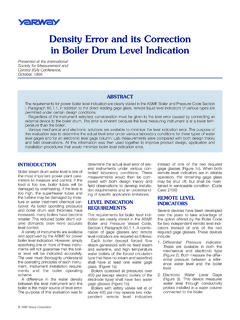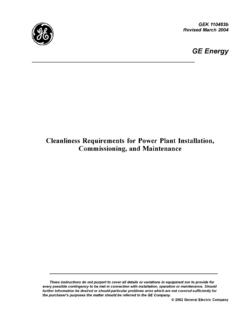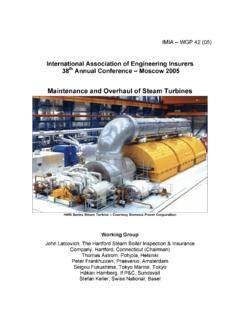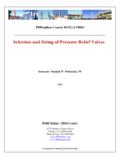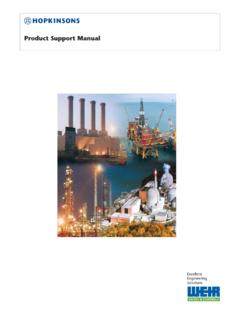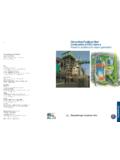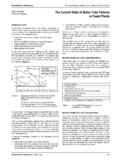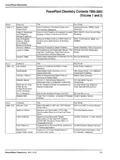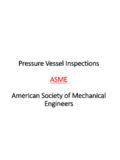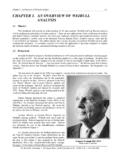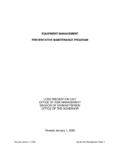Transcription of Aspects of Failure of Condenser tubes and their …
1 AKS/Journal/2010 Page 1 of 20 Aspects of Failure of Condenser tubes and their Remedial Measures at Power Plants Ashwini K. Sinha AGM (NETRA), NTPC Limited Abstract The demands placed on the condensers of utility generating units are significant. Functionally, a Condenser must condense several million pounds/kilograms per hour of wet steam at low temperatures while producing low absolute pressures. It must degasify condensate to the ppb level. These tasks must be done while also: Serving as an impervious barrier between steam/condensate and circulating water. Permitting only limited air inleakage. Contributing minimal corrosion products to the condensate in a hostile environment that is aerated, wet and at high velocity.
2 Despite the significant demands placed on the Condenser and exacting penalties for Condenser leaks, the Condenser often does not get the attention it deserves. Many of the corrosion problems in fossil fuel boilers, LP steam turbines and feedwater heaters have been traced to leaking condensers . Tube leaks allow the ingress of cooling water into the steam-water cycle. The very nature of the Condenser tends to increase a problem with cooling water leakage, in that the condensate side of the Condenser operates in a vacuum and thus any leak in a tube wall or other connection will allow cooling water to be drawn into, and contaminate, the pure condensate. The present paper intends to present different modes of Condenser tube leakages along with some case studies and possible remedial measures to prevent Failure of Condenser tubes Keywords: Crevice Corrosion, Pitting corrosion, stress corrosion cracking, dezincification, hydriding, Internal coating, cooling water treatment, treated effluent, seawater, polluted water AKS/Journal/2010 Page 2 of 20 Introduction: In a fossil power plant coal is burnt in boiler furnace to produce heat which boils the water in the boiler to produce high pressure & high temperature steam.
3 This steam is expanded across a number of turbine blades and the spent steam is condensed in a Condenser and pumped back to the steam - water cycle of the plant. The demands placed on the condensers of utility generating units are significant. Functionally, a Condenser must condense several million pounds/kilograms per hour of wet steam at low temperatures while producing low absolute pressures. It must degasify condensate to the ppb level. These tasks must be done while also: Serving as an impervious barrier between steam/condensate and circulating water. Permitting only limited air in-leakage. Contributing minimal corrosion products to the condensate in a hostile environment that is aerated, wet and at high velocity.
4 The acceptable impurity levels in cooling water are much higher than those acceptable for the condensate. This can be a problem in both once-through systems and in recirculating systems. For example, in the event of a leaking tube, cooling tower water can present a contamination problem nearly as bad as seawater because of its high hardness and high concentrations of other dissolved solids. Cooling water also often contains chemicals added to control biofouling, scale and silt. Condenser corrosion problems have increased in the past few years, in part, as a result of higher pollution in cooling water. Many of the corrosion problems in fossil fuel boilers, LP steam turbines and feedwater heaters have been traced to leaking condensers .
5 Tube leaks allow the ingress of cooling water into the steam-water cycle. The very nature of the Condenser tends to increase a problem with cooling water leakage, in that the condensate side of the Condenser operates in a vacuum and thus any leak in a tube wall or other connection will allow cooling water to be drawn into, and contaminate, the pure condensate. Condensate polishers can provide some protection against impurity ingress to the cycle; however, their capability can be overwhelmed by Condenser leaks and, during larger leaks, can be exhausted within minutes. It is difficult to place a precise figure on the cost of Condenser tube leaks to the utility industry worldwide, but results from several studies give an indication of the magnitude.
6 As per US EPRI studies Corrosion-related problems in fossil plant heat exchangers ( condensers , feedwater heaters, service water heat exchangers, lube oil coolers, etc.) have been estimated to cost approximately 360 million dollars per year in 1998 in the United States. Corrosion products picked up in the heat exchangers can lead to increased deposition of copper and iron in the boiler, causing problems such as underdeposit corrosion, and to copper deposition in high pressure turbines, leading to power losses. This aspect of the problem with condensers and heat exchangers was estimated to cost approximately $150 million per year. AKS/Journal/2010 Page 3 of 20 The impact of Condenser tube leakage can be assessed from the following data.
7 Values of different constituents' ingressing in the boiler water in case of Condenser tube leak Parameter Water quality Amount of different constituent in 1% tube leak g/hr Increase of constituent in boiler water (ppb) River Water seawater River Water seawater River Water seawater In 1 hour In 24 Hour In 1 hour In 24 Hour 1 pH 2 Conductivity 115 62280 3 Total Hardness 41 6350 7684 4 Ca Hardness 29 1100 5 Mg Hardness 12 5250 6 Chloride 5 19896 7 Sulphate 12 8 P- Alkalinity 0 0 0 0 9 M-Alkalinity 36 190 10 Silica 11 Na/K 12 12 TDS 29657 AKS/Journal/2010 Page 4 of 20 The Primary and Secondary Targets for Drum-type Boilers under Steady State Operation are given in the following table (expressed as ug/kg unless otherwise stated) Boiler-water Boiler Class Parameter 60 Bar Gas 100 Bar Coal 160 Bar Coal 180 Bar Coal 1.
8 Non-volatile Phosphate Treatment Chloride (NaCl) as Chloride < 3000 < 2000 < 1000 < 500 Silica (SiO2) (at pH - 9) < 5000 < 1500 < 300 < 200 Sulphate (SO4) <-local decision to achieve primary target in boiler water-> Disodium/ Trisodium Phosphate 2000 To 6000 2000 To 4000 1000 To 2000 1000 To 2000 All Volatile Akali Treatment Chloride (NaCl) as Chloride NA < 120 < 120 NA Silica (SiO2) (at pH - 9) < 350 <250 < 150 < 100 Sulphate (SO4) NA LD LD NA Besides changes in boiler water characteristics & consequently increase in boiler deposits and corrosion, Condenser tube leakages contribute towards enhanced copper pick up and deposition of silica/sodium on turbines, etc. Corrosion/Fouling in the Condenser tubes results in increase in turbine heat rate & reduced performance of the units.
9 In order to have sustained performance it is essential that Condenser tube leakages are prevented and cooling water system is kept clean Keeping the importance of Condenser tube leak on the plant performance in mind the present paper intends to provide a brief on different modes of Condenser tube leakages and their preventive methods. Some case studies of Condenser tube leakage investigated are also given. This is expected to give an insight to root cause analysis of Condenser tube failures remedial measures to be adopted including monitoring to be adopted to prevent failures/sustaining the performance of the plants. AKS/Journal/2010 Page 5 of 20 2. Modes of Condenser tube failures: At power plants many materials are used for Condenser tube depending on plant & cooling water requirements.
10 These include Aluminum Brass, Admiralty Brass, Copper Nickel (95/5; 90/10 & 70/30), Stainless steel (304, 304 L, 316, 316 L), Titanium, Dupleix stainless steel, Super Ferritic Stainless Steel, etc. The cooling waters can be fresh water, seawater, borewell water, brackish water, treated effluents or recycled water in either once through mode or in recirculating mode. Some of the known Failure modes of Condenser tubes are indicated below: Failure mode & identification Typical Failure 1. Erosion-Corrosion: Damage can be random, localized or Uniformly distributed. Randomly located attack is usually caused by random objects that cause partial tube blockages. Here the damage can be adjacent to, just downstream of the blockage, or just in front of the obstruction (when flow is diverted downward into the tube wall).
